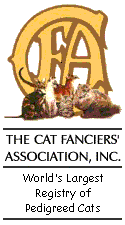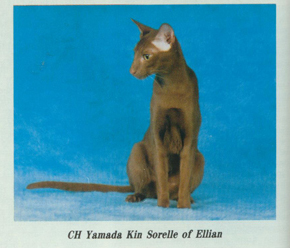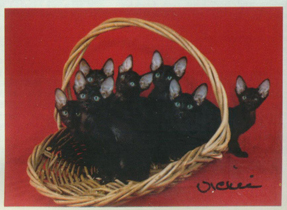

CFA
Oriental Breed Profile
CFA
Oriental Breed Standard

| |
|
CREASHIRE
CATS
Austin and Agnes Creasy
When my wife Agnes and I began breeding Oriental Shothairs one of the
first breeder females we acquired was a seal lynx point, Nakia’s Reet
Petite of Creshire. We bred her to Printer’s Liam Devlin ad got and
ebony classic tabby from the litter. Although the classic was small and
of moderate type we kept her realizing she was a rarity.
Several months later we received a call from a breeder who had heard about
our classic and was interested in acquiring a female from the litter.
She believed that the litter-mates to the classic would be classic
carriers (would carry the classic tabby gene). We had already sold the
kittens, but this conversation made me begin thinking about breeding
plans for the classic and some other kittens we were raising to be
breeders. We had used the sire of Garbo (our classic) for an earlier
breeding and had kept two females from that litter. By this time
Garbo’s mother had produced another litter with two females of breeder
quality. These four, plus Garbo’s litter sister could all be carriers
of the classic tabby gene.
At this time I was beginning to develop some understanding of the color
genetics. The gene for classic (sometimes called blotched) tabby pattern
is a recessive. This mans that both parents must carry the gene in order
to reproduce it, and only individuals who are homozygous (inherited the
genes from both parents) will be a classic on appearance. There are
three ways that one can be certain that an individual is a carrier:
1.
It is classic in appearance.
2.
One of its parents is a classic.
3.
It has produced classic offspring.
Having parents that are carriers or having grandparents that are classics
only gives an individual the possibility of being a carrier. The classic
pattern can also be masked over by an individual being homozygous
non-agouti (solid color). Also the Siamese of Colorpoint pattern can
mask all of the classic pattern except the tail.
In considering all of the above constraints it became obvious that we
needed a classic male. This would permit us to produce classics from
Garbo and her mother and test breed the other possible carriers. The
offspring from all such breedings would be known carriers. On May 30,
1988 we called everyone that we knew who was breeding classic tabby
Orientals. We were very fortunate to acquire from Sally Abbott, Typha
Cattery, a young classic male who would be mature enough for breeding at
the time our females would be ready. Typha’s Tumbleweed of Creshire
was bred to: Garbo; Reet Petite, Garbo’s mother; Galadriel, Garbo;s
litter sister; and two other females that proved not to be carriers.
From these breedings we have kept Vincent Price, ebony classic male;
Victoria and Vectra, blue lynx point classic females; Bogart, ebony
classic male; Bacall, ebony classic female; Bastet, ebony ticked tabby
female (now in West Germany); Blynn, solid ebony female; Several
carriers from the test breedings. Some of these we have placed with
another breeder with whom we are working on reciprocal basis. The
remainder we are breeding to improve type and pattern. We always breed
with at least one parent being classic so as to be certain that all
progeny are carriers.
SHADES
AND STRIPES
Shaded Silvers and classic tabbies are coat patterns often seen in other
breeds, if only rarely in Orientals. One pair of colors that is unique
to the Oriental however, is solid cinnamon and fawn. As I mentioned
earlier in this article, the cinnamon gene has been around for a while.
The color we call cinnamon is the dame color that makes the red
Abyssinian RED. The cinnamon color is also seen in spots on Ocicats,
which derived from Abyssinians and Siamese. It may have originated
genetically as a new color mutation or by regular sex-linked red moving
off the X chromosome. The former is probably more likely as the color is
not the same as red, it is intermediate between red and chestnut.
Orientals got the cinnamon gene rather indirectly from an Aby-Siamese
British cross. A few dedicated breeders are slowly expanding the
population of cinnamons and fawns, one notable breeder who has been
working with the color is Linda Kochis of Ellian cattery. |
|
ELLIAN
Linda Kochis
Cinnamon is the light brown gene recessive to chestnut. The color was
introduced from a red Abyssinian outcross made in
Great Britain
during the 1960’s. A small number of dedicated breeders working with
Dutch and English imports have made great progress with the type in
these cats. Several show quality
OSH
who carry the gene have graced the show bench in the past few years.
Fawn, the blue dilution of cinnamon, is truly a rare color and its
progress has been slower.
My daughter Elayne and I started breeding 10 years ago with a lovely line
bred Petmark chocolate point., Faro Garlinthias of Ellian, a Nescafe
daughter. She came to us on breeder’s terms as a way of filling the
void left in our lives by the death of our 16 year old Gaidon, chocolate
point Siamese. Originally we were just going to have one litter, give
the pick to her breeder, Ethyl duBois, and keep the other kittens as
neutered pets. But I soon became obsessed with the idea of actually
breeding a cinnamon and then working to breed one of show quality. In
order to gain my husband Andy’s support in this goal, I agreed to keep
our full time adult population at 8 cats and not spend high fees for
stud service or for new cats. I’m sure this slowed down progress in
our breeding program but I’ve been content raising 2 to 3 litters per
year and building up the line step by step. With few exceptions, every
breeding produced kittens of better quality than their parents.
I’ve followed a pattern of outcrossing for type then inbreeding to
retain color. Galinthias was bred to a cinnamon son of the original
English import Southview Peromone. Her cinnamon grandson, CH Ellian
Kinnamon, was outcrossed to a typey chocolate point, Barnwood Dominoe of
Ellian, an AOV from Singa, Sand N’ Sea, and Quire’s Gal-X-C lines.
Dominoe’s cinnamon grandson CH Ellian Sundancer was a major step
forward in type. By doubleing up on Dominoe and outcrossing to Petra
Pfaffe’s (Cherrygarden) Dutch cinnamon line, I was the happy
co-breeder with Debbie Baehr of a vigorous and healthy litter of 4
cinnamon and 3 chestnut Sundancer grandkittens. Naturally, the chestnuts
were pick of the litter. The male GRP Yamada Kin Sorelle of Ellian* is,
I believe, the best cinnamon seen on the show bench to date. Judges from
Holland
,
Great Britain
, and
Germany
said they had never seen a better one in
Europe
. Sorelle made some kitten finals and picked up a few grand points
before being pulled to be bred.
Our foundation cinnamons were large, heavy boned, deep chested, plush
coated, round eyed cats. It took 6 generations of breeding here at
Ellian to produce a cinnamon of Sorelle’s quality. The challenge in
the coming years will be, to retain the progress we have made, regain
the sweeter temperament of our foundation cats, and to lower the ear
set, and improve eye shape.
|

|
|
THE
RIGHT CLASS
The Oriental Shorthair is the only breed among several breeds derived from
the Siamese who have kept the same type standard. Balinese cats were
bred from the long-haired kittens born periodically to Siamese cats.
Colorpoints, like the Orientals, resulted in a deliberate outcross to
obtain new colors. The Javanese is the longhaired version of the
colorpoint. Together these four breeds, representing the Siamese type
– dominate shorthair classes in CFA. A similar sort of situation
exists in the longhair breeds with Persians which are the very oldest
pedigreed cat. Himalayans were developed intentionally by crossing to
Siamese cats for color and back to Persian for type. The Exotic
Shorthairs were created by outcrossing to shorthaired cats and back to
Persians for type. Not all possible colors are yet allowed in the
Persians divisions, but the Himmy is now (they weren’t always) just a
division of Persian and not a separate breed, while long haired cats out
of exotics are not yet allowed to compete for championship.
For the first seven years of
OSH
in championship all pointed Orientals were AOV’s and not eligible for
championship competition. On 1984-85 CFA decided that the colorpoint
oriental was colorwise, typewise, and ancestrywise, the same feline as
the Colorpoint Shorthair and allowed those colors to compete with the
CPSH. This, I believe is a completely novel situation. The Oriental
Colorpoints have a different registration number series from the CPSH
colorpoints and people who breed and grand colorpoint Orientals in the
colorpoint class are eligible for OSH breed council membership but not
CPSH breed council membership, even if they have never shown a cat in an
Oriental Shorthair class!
In 1984-85 CFA’s best Colorpoint Shorthair was an Oriental named
Tintadel’s Rose By Any Other Name, a tortie-point bred and owned by
Erica Mueller. In 1986-87 both CPSH winners were “real” Colorpoints,
but in 87-88 both were Orientals. The best Colorpoint was Glor-ee’s
Road Warrior bred and owned by Susan and Gloria Adler and 2nd
best was Magpie’s Sparkle Freelee bred by Linda Doty and owned by Ken
Northrup. That general pattern seems now to be the rule. Roughly half of
the cats shown in the colorpoint class are Orientals as are about half
of the cats that earn Grand Champion titles in those classes.
In keeping with this some people whose breeding programs revolve around
colorpoints only use Siamese and CPSH cats in their programs while
others pay attention to color and type and have Oriental cats in their
programs. There are very few problems remaining with this system. One of
which is the Siamese to Colorpoint to Oriental hierarchy which causes a
colorpointed cat with only one distant Oriental ancestor to be ab
Oriental. From competition this poses no problem but it can make it
difficult for a breeder to produce Colorpoints with the aim to earn
breed council membership so as to have input into the future of their
cats in CFA. The only other problem is for the Javanese breeders who are
currently limited to Siamese, Balinese and Colorpoint Shorthairs for
outcrosses. Without access to the pointed Orientals they are excluded
from the large pool of tabby and red genes.
It will b interesting to see how these issues are dealt with in the next
few years. Most, but certainly not all, OSH breeders hope for a
classification system similar to that that the Persian breeds enjoy,
with registration numbers indicating ancestry, allowing for competition
based simply on type and color while also protecting the purity of the
Siamese and related breeds.
No one would argue that the
Oriental Shorthairs are colorful, lively and successful (which could
also describe those who breed them). They have been a great success,
winning many competitions and many cat fanciers hearts and minds all
across the country. May they forever be successfully lean and elegant,
sleek and graceful, personable and a bit extreme.
Note from the author: This is an
historical account of the Oriental Shorthair from its genesis through
1989. Next year I will continue with more recent events, and associated
history as well, such as the stellar careers of Leggs Amapola of
Mayflower and Webb-Barrs Beaux, as well as the Orientals of the
1993-1993 season.
|
| Author’s
Bio: I was born in
Oakland
,
California
in 1957. I grew up in
California
and
Oregon
and always had a deep affection for cats although I was completely
unfamiliar with the pedigreed varieties. I went to
Chicago
in the late 70’s to study biology at the
University
of
Chicago
. I met a first generation silver ticked tabby Oriental Shorthair there
in 1981, but must admit I paid no special attention to her at the time.
After I graduated from college in 1982 I moved to
New York City
where I worked in the laboratory of Dr. S. Alex Stalcup. Alex and his
family lived two blocks from me near the hospital in a run-down
neighborhood attached to the north end of
Harlem
, they quickly became good friends of mine. They bred Oreintal
Shorthairs which they obtained from Barbara Levitan (Felitan). One blue
silver spotted tabby boy (CH Temeluphils Thromboxane of Synergy)
attached himself to me like glue so he had to live with me. Within two
years I was a certified clerk and had a small silver program. I was at
the first meeting of Oriental Shorthairs of America, which I immediately
joined. I am now a board member in OSA and the genetics editor and
columnist for OSA’s newsletter, Tails
of the Orient. I also belong to Empire Cat Club. This article was
started in 1987, at which point I had been talked into helping to gather
information for the article as I knew and lived near a number of the
people who were instrumental in the founding of the breed in CFA.
Somehow I ended up, somewhat unwillingly, with the whole article in my
lap. Throughout the preparation of this article I was in graduate school
at
Columbia
University
. I earned my MA in 1988, my MPhil in 1989 and my PhD in May 1992. I
have since moved to
Seattle
where I hold a post doctoral position at the
University
of
Washington
in the Department of Genetics. It was not an ideal time to be writing a
feature for the Yearbook. Nonetheless, it has been a voyage of discovery
for me, I hope it is for you too. The Oriental Shorthair is a very big
breed in CFA right now, and I know I have not covered everything and
everybody. Please forgive me if I left you our, and please fill me in
for next year.

Litter of Dajen Kittens
|
SOME
DEFINITIONS
First
the colors, which are not standardized in all the breeds.
Ebony:
Black. Sable in Burmese, seal in Siamese and Colorpoint Shorthairs,
natural mink in Tonkinese.
Ebony
Tabby: Black Tabby pattern on a brown background, called brown tabby
in many other breeds, bronze in Egyptian Mau, ruddy in the Abyssinian.
Ebony
Silver Tabby: Black tabby pattern on a silver-white background,
called silver tabby in other breeds.
Blue:
Grey, the dilute of black, called blue in most breeds.
Blue
Tabby: Grey tabby pattern on a warm cream background. Called blue
tabby in other breeds.
Blue
Silver Tabby: Grey pattern on a silver-white background. Called blue
silver tabby in breeds that recognize the color.
All
the colors listed below have tabbies and silver tabbies as listed above,
as in the blue tabby. The tabby pattern is of the color listed and the
background color is warm cream unless the tabby is silver, in which case
the background is silver-white.
Chestnut:
Brown, called chocolate in Siamese.
Lavender:
Cool beige or taupe, the dilute of brown, called lilac in Siamese.
Cinnamon:
Hot cinnamon brown, called red in the Abyssinian, sometimes called light
chocolate in the British Siamese.
Fawn:
Warm fawn, the dilution of cinnamon, same as fawn in Abyssinian.
Red:
Orange
to brick red, called red in most other breeds, flame in the Himalayan
Persians, is not the same as Abyssinian red (see cinnamon).
Note: Cameo tabbies are red silver tabbies.
Cream:
Dark cream to peach to pumpkin color, the dilution of red. Called cream
in most breeds. Again note that a dilute cameo is a cream silver.
Smoke:
A cat of any of the solid colors listed above who is silver but not
tabby. The undercoat is silver-white. Unlike the Persian or Egyptian Mau
color standard the Oriental color standard requires that the silver
undercoat not be visible when the cat is in repose. The silver should
only show when the cat is in motion or the coat is pulled back.
NOW
ONTO THE GENETICS TERMS:
Allele:
One copy of a gene, usually referred to by a letter which refers to a
visible trait, ie A is tabby, a is solid, B is black, and b is brown.
Capital letters are dominant traits, lower case letters are recessive,
the letter itself is one gene. In other words B and b are alleles of the
color gene.
Chromosome:
A very large piece of DNA, containing a multitude of genes, inside an
animal’s cells which are inherited from the animal’s parents. Every
cat (or person) has two of each chromosome one inherited from the mother
and one from the father.
Dominant:
An allele (version of a gene) which is apparent in only one copy. For
example, the color black, a black cat can “carry” other colors
because black is dominant.
Gene:
A unit of inheritance technically a region of a chromosome that codes
for a single protein.
Genotype:
The genetic makeup of a living organism.
Heterozygous:
Having two different alleles of one gene.
Homozygous:
Having two copies of one allele of a gene.
Phenotype:
The appearance of a living organism, in the case of dominant genes, such
as black in the cat, the phenotype does not indicate whether the cat is
heterozygous or homozygous.
Recessive:
An allele which must exist in two copies to be apparent. For example the
Siamese or “pointed” colors, a black cat may “carry” Siamese
color, so two black cats bred together can produce a seal point, but two
seal points bred together can only produce pointed cats because both
parents must have been homozygous for the Siamese color.
|
|
